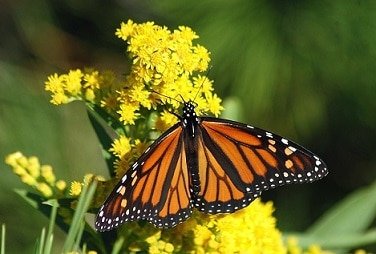Migratory Monarch butterfly whose scientific name is Danaus plexippus plexippus has come under the Red list of threatened species of IUCN.
The migratory monarch butterfly is a stunning and iconic species known for its impressive annual migration. Each year, millions of monarchs embark on a journey that spans thousands of miles, traveling from as far north as Canada to overwintering sites in Mexico and California. The butterfly is known for its annual journey of approximately 4000 kms
The monarch’s migration is a truly remarkable feat, requiring the butterfly to navigate through a variety of landscapes and weather conditions. The butterflies begin their journey in the late summer and early fall, traveling southward to reach their overwintering sites by late October or early November. Along the way, they stop to feed and rest, building up the energy reserves they will need for the next leg of their journey.

One of the most striking aspects of the monarch’s migration is the synchronized timing of their journey. Despite the fact that monarchs are born at different times throughout the summer, they all manage to arrive at the overwintering sites at the same time. Scientists believe that the butterflies use a combination of cues, such as the position of the sun and the changing day length, to navigate and time their migration.
Once the monarchs reach their overwintering sites, they congregate in large groups, often numbering in the millions. The butterflies spend the winter in a dormant state, conserving energy until the temperatures begin to warm up in the spring. As the days grow longer and the weather gets warmer, the monarchs begin to stir, eventually emerging from their dormant state and taking to the air once again.
The monarch’s spring migration is just as impressive as their fall migration, as they travel northward to their summer breeding grounds. Along the way, they stop to lay eggs and nectar on milkweed plants, which serve as the main food source for the monarch caterpillars.
Despite the monarch’s impressive migration and the important role they play in the ecosystem, their population has been declining in recent years. Habitat loss, pesticide use, and climate change are all thought to be contributing factors to the decline.
To help protect the monarch and ensure the survival of this iconic species, conservation efforts are underway. These include planting milkweed and other nectar-rich plants, reducing pesticide use, and protecting overwintering sites.
In conclusion, the migratory monarch butterfly is a truly remarkable species, known for its impressive annual migration. The synchronized timing of their journey, combined with the large congregations of butterflies at the overwintering sites, make it an awe-inspiring phenomenon to witness. However, their population has been declining in recent years, and conservation efforts are underway to protect and preserve this iconic species for future generations to enjoy.
Is Migratory Monarch butterfly found in India?

The monarch butterfly (Danaus plexippus) is primarily found in North and South America, and some parts of Australia and New Zealand. The butterfly is known for its distinctive orange and black wings, and its long-distance annual migration.
What is the name of migratory monarch butterflies?
Migratory Monarch butterfly scientific name is Danaus plexippus plexippus.
Which place monarch butterfly started migrating?
Each year, millions of monarchs embark on a journey that spans thousands of miles, traveling from as far north as Canada to overwintering sites in Mexico and California.
Where does the monarch butterfly live?
Monarch butterflies lives in prairies, meadows, grasslands and along roadsides.